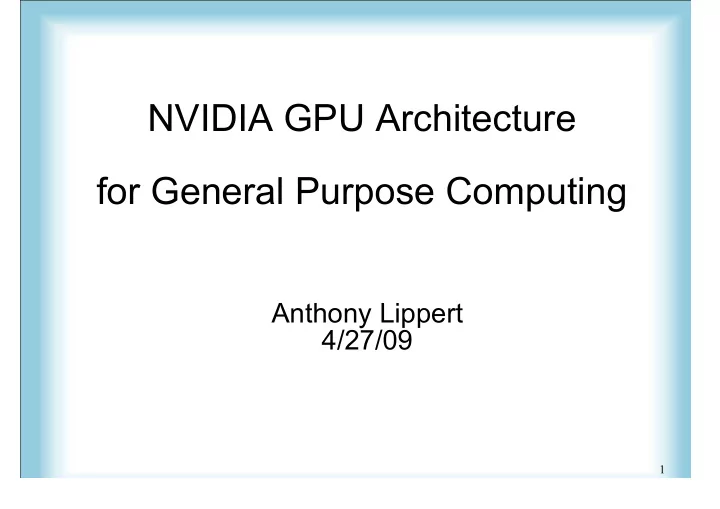

NVIDIA GPU Architecture for General Purpose Computing Anthony Lippert 4/27/09 1
Outline Introduction GPU Hardware Programming Model Performance Results Supercomputing Products Conclusion 2
Intoduction GPU: Graphics Processing Unit Hundreds of Cores Programmable Can be easily installed in most desktops Similar price to CPU GPU follows Moore's Law better than CPU 3
Introduction Motivation: 4
GPU Hardware Multiprocessor Structure: 5
GPU Hardware Multiprocessor Structure: N multiprocessors with M cores each SIMD – Cores share an Instruction Unit with other cores in a multiprocessor. Diverging threads may not execute in parallel. 6
GPU Hardware Memory Hierarchy: Processors have 32-bit registers Multiprocessors have shared memory, constant cache, and texture cache Constant/texture cache are read- only and have faster access than shared memory. 7
GPU Hardware NVIDIA GTX280 Specifications: 933 GFLOPS peak performance 10 thread processing clusters (TPC) 3 multiprocessors per TPC 8 cores per multiprocessor 16384 registers per multiprocessor 16 KB shared memory per multiprocessor 64 KB constant cache per multiprocessor 6 KB < texture cache < 8 KB per multiprocessor 1.3 GHz clock rate Single and double-precision floating-point calculation 1 GB DDR3 dedicated memory 8
GPU Hardware Thread Scheduler Thread Processing Clusters Atomic/Tex L2 Memory 9
GPU Hardware Thread Scheduler: Hardware-based Manages scheduling threads across thread processing clusters Nearly 100% utilization: If a thread is waiting for memory access, the scheduler can perform a zero-cost, immediate context switch to another thread Up to 30,720 threads on the chip 10
GPU Hardware Thread Processing Cluster: 11 IU - instruction unit TF - texture filtering
GPU Hardware Atomic/Tex L2: Level 2 Cache Shared by all thread processing clusters Atomic − Ability to perform read-modify-write operations to memory − Allows granular access to memory locations − Provides parallel reductions and parallel data structure management 12
GPU Hardware 13
GPU Hardware GT200 Power Features: Dynamic power management Power consumption is based on utilization − Idle/2D power mode: 25 W − Blu-ray DVD playback mode: 35 W − Full 3D performance mode: worst case 236 W − HybridPower mode: 0 W On an nForce motherboard, when not performing, the GPU can be powered off and computation can be diverted to the motherboard GPU (mGPU) 14
GPU Hardware 10 Thread Processing Clusters(TPC) 3 multiprocessors per TPC 8 cores per multiprocessor ROP – raster operation processors (for graphics) 1024 MB frame buffer for displaying images Texture (L2) Cache 15
Programming Model Past: The GPU was intended for graphics only, not general purpose computing. The programmer needed to rewrite the program in a graphics language, such as OpenGL Complicated Present: NVIDIA developed CUDA, a language for general purpose GPU computing Simple 16
Programming Model CUDA: Compute Unified Device Architecture Extension of the C language Used to control the device The programmer specifies CPU and GPU functions − The host code can be C++ − Device code may only be C The programmer specifies thread layout 17
Programming Model Thread Layout: Threads are organized into blocks . Blocks are organized into a grid . A multiprocessor executes one block at a time. A warp is the set of threads executed in parallel 32 threads in a warp 18
Programming Model Heterogeneous Computing: − GPU and CPU execute different types of code. − CPU runs the main program, sending tasks to the GPU in the form of kernel functions − Multiple kernel functions may be declared and called. − Only one kernel may be called at a time. 19
Programming Model: GPU vs. CPU Code D. Kirk. Parallel Computing: What has changed lately? Supercomputing , 2007 20
Performance Results 21
Supercomputing Products Tesla C1060 GPU 933 GFLOPS nForce Motherboard Tesla C1070 Blade 4.14 TFLOPS 22
Supercomputing Products Tesla C1060: Similar to GTX 280 No video connections 933 GFLOPS peak performance 4 GB DDR3 dedicated memory 187.8 W max power consumption 23
Supercomputing Products Tesla C1070: Server Blade 4.14 TFLOPS peak performance Contains 4 Tesla GPUs 960 Cores 16GB DDR3 408 GB/s bandwidth 800W max power consumption 24
Conclusion SIMD causes some problems GPU computing is a good choice for fine-grained data-parallel programs with limited communication GPU computing is not so good for coarse-grained programs with a lot of communication The GPU has become a co-processor to the CPU 25
References D. Kirk. Parallel Computing: What has changed lately? Supercomputing , 2007. nvidia.com NVIDIA. NVIDIA GeForce GTX 200 GPU Architectural Overview. May, 2008. NVIDIA. NVIDIA CUDA Programming Guide 2.1. 2008. 26
Recommend
More recommend